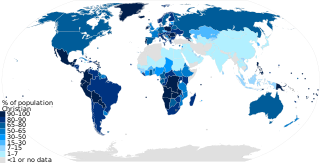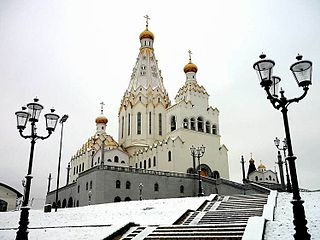Related Research Articles

Liechtenstein, officially the Principality of Liechtenstein, is a doubly landlocked German-speaking microstate in the Central European Alps, between Austria in the east and north and Switzerland in the west and south. Liechtenstein is a semi-constitutional monarchy headed by the prince of Liechtenstein of the House of Liechtenstein, currently led by Hans-Adam II. It is Europe's fourth-smallest country, with an area of just over 160 square kilometres and a population of 40,023. It is the world's smallest country to border two countries, and is one of the few countries with no debt.
Demographic features of the population of Liechtenstein include population density, ethnicity, education level, health of the populace, economic status, religious affiliations and other aspects of the population.

Vaduz is the capital of Liechtenstein and also the seat of the national parliament. The city, which is located along the Rhine, has 5,696 residents. The most prominent landmark of Vaduz is Vaduz Castle, perched atop a steep hill overlooking the city. It is home to the reigning prince of Liechtenstein and the Liechtenstein princely family. The city's distinctive architecture is also displayed in landmarks such as the Cathedral of St. Florin, Government House, City Hall, the National Art Gallery, as well as the National Museum. Although Vaduz is the best-known town in the principality internationally, it is not the largest; neighbouring Schaan has a larger population.

The principality of Liechtenstein is divided into eleven municipalities, most consisting of only a single town. Five of the Gemeinden fall within the electoral district of Unterland, while the other six are within the Oberland.

Christianity is the most widely professed religion in Argentina, with Roman Catholicism being its largest denomination. This historical background is very much due to the Spanish influence brought about through the newly conquered territories. However, affiliation with Protestant churches is increasing and immigration throughout the 20th century has brought other religions from various regions to Argentina.

Christianity is the largest religion in Belgium, with the Catholic Church representing the largest community, though it has experienced a significant decline since the 1950s. Belgium's policy separates the state from the churches, and freedom of religion of the citizens is guaranteed by the country's constitution.

Christianity is the largest religion in Germany. It was introduced to the area of modern Germany by 300 AD, while parts of that area belonged to the Roman Empire, and later, when Franks and other Germanic tribes converted to Christianity from the fifth century onwards. The area became fully Christianized by the time of Charlemagne in the eighth and ninth century. After the Reformation started by Martin Luther in the early 16th century, many people left the Catholic Church and became Protestant, mainly Lutheran and Calvinist. In the 17th and 18th centuries, German cities also became hubs of heretical and sometimes anti-religious freethinking, challenging the influence of religion and contributing to the spread of secular thinking about morality across Germany and Europe.

As of the year 2023, Christianity had approximately 2.4 billion adherents and is the largest religion by population. According to a PEW estimation in 2020, Christians made up to 2.38 billion of the worldwide population of about 8 billion people. It represents nearly one-third of the world's population and is the largest religion in the world, with the three largest groups of Christians being the Catholic Church, Protestantism, and the Eastern Orthodox Church. The largest Christian denomination is the Catholic Church, with 1.3 billion baptized members. The second largest Christian branch is either Protestantism, or the Eastern Orthodox Church.

Religion has been a major influence on the societies, cultures, traditions, philosophies, artistic expressions and laws within present-day Europe. The largest religion in Europe is Christianity. However, irreligion and practical secularisation are also prominent in some countries. In Southeastern Europe, three countries have Muslim majorities, with Christianity being the second-largest religion in those countries. Ancient European religions included veneration for deities such as Zeus. Modern revival movements of these religions include Heathenism, Rodnovery, Romuva, Druidry, Wicca, and others. Smaller religions include Indian religions, Judaism, and some East Asian religions, which are found in their largest groups in Britain, France, and Kalmykia.

The majority of Vietnamese do not follow any organized religion, instead participating in one or more practices of folk religions, such as venerating ancestors, or praying to deities, especially during Tết and other festivals. Folk religions were founded on endemic cultural beliefs that were historically affected by Confucianism and Taoism from ancient China, as well as by various strands of Buddhism. These three teachings or tam giáo were later joined by Christianity which has become a significant presence. Vietnam is also home of two indigenous religions: syncretic Caodaism and quasi-Buddhist Hoahaoism.

The Archdiocese of Vaduz, which was erected in 1997, is a Latin Church diocese of the Catholic Church which encompasses the entire territory of the Principality of Liechtenstein.

Serbia has been a predominantly Christian country since the Christianization of Serbs by Clement of Ohrid and Saint Naum in the 9th century. The dominant confession is Eastern Orthodoxy in the fold of Serbian Orthodox Church.

Religion in Italy has been historically characterised by the dominance of the Catholic Church, the largest branch of Christianity, since the East–West Schism. This is in part due to the importance of Rome in the history of the Church, including its historical status as a leading patriarchate and the presence of the Vatican, the Catholic Church's headquarters and the residence of the Pope—the Bishop of Rome—within its borders. However, due to immigration, notably the influx of Muslims, Eastern Orthodox Christians, Protestants, Buddhists and Hindus, as well as proselytism and secularization, religious pluralism in Italy has increased in the 21st century. Italy also features a pre-Christian Jewish community, an autochthonous Protestant church–the Waldensian Evangelical Church and one of the largest shares of Jehovah's Witnesses in the world.

Christianity is the prevalent religion in the United States. A recent Gallup survey from 2023 indicates that of the entire U.S. population about 67% is Christian. The majority of Christian Americans are Protestant Christians, though there are also significant numbers of American Roman Catholics and other Christian denominations such as Latter Day Saints, Eastern Orthodox Christians, Oriental Orthodox Christians, and Jehovah's Witnesses. The United States has the largest Christian population in the world and, more specifically, the largest Protestant population in the world, with nearly 210 million Christians and, as of 2021, over 140 million people affiliated with Protestant churches, although other countries have higher percentages of Christians among their populations. The Public Religion Research Institute's "2020 Census of American Religion", carried out between 2014 and 2020, showed that 70% of Americans identified as Christian during this seven-year interval. In a 2020 survey by the Pew Research Center, 65% of adults in the United States identified themselves as Christians. They were 75% in 2015, 70.6% in 2014, 78% in 2012, 81.6% in 2001, and 85% in 1990. About 62% of those polled claim to be members of a church congregation.

Christianity is the main religion in Belarus, with Eastern Orthodoxy being the largest denomination. The legacy of the state atheism of the Soviet era is apparent in the fact that a proportion of Belarusians are not religious. Moreover, other non-traditional and new religions have sprung up in the country after the end of the Soviet Union.

Christianity is the largest religion in Uruguay, with Catholics having the most adherents, but around 44.5% of the population is non-religious as of 2021. Church and state are officially separated since 1916.

Christianity is the largest religion in Madagascar, with Protestantism and Catholicism being its main denominations.
Religion in Guinea-Bissau is diverse, with no particular religion comprising an absolute majority of the population. Islam is the most widely professed faith, and significant populations of Christians and adherents of traditional African religions are also present in the country.

Religion in Eritrea consists of a number of faiths. The two major religions in Eritrea are Christianity and Islam. However, the number of adherents of each faith is subject to debate. Estimates of the Christian share of the population range from 47% and 63%, while estimates of the Muslim share of the population range from 37% to 52%.

Christianity is the largest religion in Tanzania, professed by around 63.1% of the total population as of 2020. Protestantism and Catholicism are the main denominations in the country.
References
- 1 2 Amt für Statistik. "213.001d Ständige Bevölkerung nach Stichtag und Religion". PX-Web (in German). Retrieved 9 June 2023.
- 1 2 "2022 Report on International Religious Freedom: Liechtenstein". United States Department of State. Retrieved 16 February 2024.
- 1 2 Jeroen Temperman (30 May 2010). State-Religion Relationships and Human Rights Law: Towards a Right to Religiously Neutral Governance. BRILL. pp. 44–45. ISBN 978-90-04-18148-9 . Retrieved 31 July 2012.
- 1 2 Aili Piano (30 September 2009). Freedom in the World 2009: The Annual Survey of Political Rights & Civil Liberties. Rowman & Littlefield. p. 426. ISBN 978-1-4422-0122-4 . Retrieved 31 July 2012.
- ↑ "Global Restrictions on Religion" (PDF). Pew Research Center. Archived from the original (PDF) on 17 January 2013.
- ↑ Thomas M. Eccardt (30 October 2005). Secrets of the Seven Smallest States of Europe: Andorra, Liechtenstein, Luxembourg, Malta, Monaco, San Marino, and Vatican City. Hippocrene Books. p. 123. ISBN 978-0-7818-1032-6 . Retrieved 31 July 2012.
- ↑ Encyclopædia Britannica Almanac 2009 . Encyclopædia Britannica. 25 March 2009. p. 392. ISBN 978-1-59339-839-2 . Retrieved 31 July 2012.
- 1 2 3 Statistisches Jahrbuch Liechtensteins 2020 Llv.li, p. 80
- ↑ "Volkszählung 2010". Llv.li. Retrieved 3 August 2017.
- 1 2 3 Statistisches Jahrbuch Liechtensteins 2014 Llv.li, p. 80
- ↑ "Bevölkerungsstruktur". www.statistikportal.li (in German). The fourth graph. Archived from the original on 29 January 2023. Retrieved 16 February 2024.
- ↑ Freedom House website, retrieved 2023-08-08
